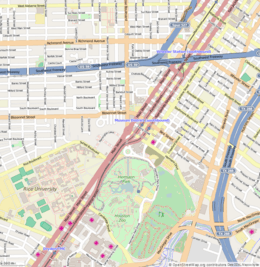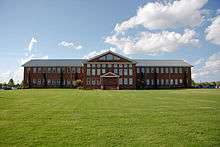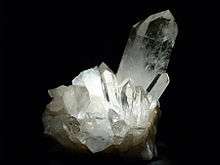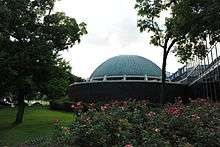Houston Museum of Natural Science
 Southeast entrance to HMNS. | |
| Established | 1909 |
|---|---|
| Location | Houston, Texas |
| Type | Science museum |
| Public transit access | |
| Website |
www |

The Houston Museum of Natural Science (abbreviated as HMNS) is a science museum located on the northern border of Hermann Park in Houston, Texas, United States. The museum was established in 1909 by the Houston Museum and Scientific Society, an organization whose goals were to provide a free institution for the people of Houston focusing on education and science. Museum attendance totals over two million visitors each year. The museum complex consists of a central facility with four floors of natural science halls and exhibits, the Burke Baker Planetarium, the Cockrell Butterfly Center, and the Wortham Giant Screen Theatre (formerly known as the Wortham IMAX Theatre). The museum is one of the most popular in the United States and ranks just below New York City's American Museum of Natural History and Metropolitan Museum of Art and the M. H. de Young Memorial Museum in San Francisco in most attendance amongst non-Smithsonian museums.[1] Much of the museum's popularity is attributed to its large number of special or guest exhibits.

History
The initial museum organization was called the Houston Museum and Scientific Society, Inc., and was created in 1909. The museum's primary collection was acquired between 1914 and 1930. This included the purchase of a natural-history collection assembled by Henry Philemon Attwater and a donation from collector John Milsaps, the latter of which formed the core of the museum's gem and mineral collection.[2] First housed in Houston's city auditorium, the collection was subsequently housed in the Central Library for seven years, and then at a site in the Houston Zoo in 1929. The museum's now wide-ranging education programs began in 1947 and, in its second year, hosted 12,000 children.[3]
The museum was officially renamed the Houston Museum of Natural Science in 1960. Construction of the current facility in Hermann Park began in 1964 and was completed in 1969.[4]
By the 1980s, the museum's permanent displays included a dinosaur exhibit, a space museum, and exhibits on geology, biology, petroleum science, technology, and geography. In 1988, the Challenger Learning Center was opened in memory of the Space Shuttle Challenger crewmembers that were lost during the shuttle's tenth mission. The center's aim is to teach visitors about space exploration. The Wortham IMAX Theatre and the offsite George Observatory were opened in 1989.
Museum attendance was more than one million visitors in 1990. HMNS trustees determined that new state-of-the-art facilities, additional space, and renovations to current exhibits were needed because of the increased attendance. Between 1991 and 1994, a number of exhibit halls were renovated and the expansion of the Sterling Hall of Research was completed. The Cockrell Butterfly Center and the Brown Hall of Entomology opened in July 1994.

In March 2007, the museum opened the HMNS Woodlands X-ploration Station, located in the Woodlands Mall. The facility was home to an interactive Dig Pit, where children could excavate a mock Triceretops, a variety of living exhibits, fossils, and minerals. The Woodlands location closed on September 7, 2009, less than a month before HMNS opened a satellite museum in Sugar Land, Texas.[5]
HMNS celebrated its 100th year in 2009. During that year, the museum offered a multitude of family programs, lectures, free events, and kids' classes as part of the "Fun Hundred" celebration.[6]
On October 3, 2009, HMNS opened its satellite museum in Telfair, Sugar Land.[7] The building and surrounding land that became HMNS at Sugar Land was once part of the Central Unit, a Texas Department of Criminal Justice prison that had been unoccupied for several decades.
In March 2012, the Wortham IMAX Theatre was converted from 70 mm film to 3D digital and renamed the Wortham Giant Screen Theatre.[8]
In June 2012, HMNS opened a new 230,000 square foot wing to house its paleontology hall, more than doubling the size of the original museum. Paleoartist, Julius Csotonyi, created fourteen murals based closely on concept drawings by HMNS Curator of Paleontology, Robert Bakker, for the new paleontology hall.[9][10] The Morian Hall of Paleontology contains more than 60 large skeleton mounts, including four Tyrannosaurus rex and three large Quetzalcoatlus.
Permanent Exhibits

- The Foucault pendulum, demonstrating the Earth's rotation. The length of the pendulum's cable is over 60 feet (18 m) long.
- Cullen Hall of Gems & Minerals, featuring a large exhibit of over 750 crystallized mineral specimens and rare gemstones.
- Lester and Sue Smith Gem Vault, showcasing some of the most exquisite finely cut gems in jewelry.
- Farish Hall of Texas Wildlife exhibits animals and wildlife native to Texas. The hall contains a video wall that displays the plants, animals and topography of the seven biotic regions of the state.
- Evelyn and Herbert Frensley Hall of African Wildlife, a display of taxidermied animals, including one of only two forest giraffes exhibited in North America. Opening in 1969, the hall allows visitors to explore the seven biomes of the continent of Africa. Contains over 120 specimens, including 42 species of birds and 28 species of mammals are on display.
- Strake Hall of Malacology, with many specimens of mollusks.
- Morian Hall of Paleontology, one of the largest paleontology halls in the United States. Contains over 60 major skeleton mounts, including three Tyrannosaurus rex, a Diplodocus and the most complete Triceratops skeleton ever discovered. It also houses one of the largest trilobite collections in existence. Robert Bakker serves as Curator of Paleontology.[11]
- John P. McGovern Hall of the Americas, showing more than 50 cultures worth of pre-Columbian archaeological artifacts.
- Welch Chemistry Hall, with interactive chemistry related displays and a periodic table of elements with a sample of each element.
- Weiss Energy Hall, with displays themed around energetics, petroleum geology, and oil exploration. The hall consists of 12 sections which include the Energy Explorations Theater, the Geovator (which takes visitors on a simulated trip to the bottom of a 7,285 ft (2,220 m). well), the Energy Excursions Theater and the Alternative Energy Sources exhibit. The exhibit closed in Fall 2016 due to major renovations but the exhibit will reopen in 2017.
- Hall of Ancient Egypt opened in May 2013 and contains many millennia-old artifacts and features recreations of Egyptian temples and mummies from this ancient primary civilization.
- Cockrell Sundial opened in 1989 and is one of the world's largest sundials. It includes lenses on a special chrome ball on top of the gnomon so that at solar noon on the equinoxes and solstices, sunlight shines though and casts an image of the Sun. Large sunspots can be seen by holding a white card in the beam and moving until it is focus.
- Earth Forum, which opened in 2002, is a computer-aided and hands-on exhibit teaching about Earth and its processes. The "Earth Update" software was developed by Rice University with NASA funding.[12]
Facilities


Opening in 1964, the Burke Baker Planetarium presents a range of science and astronomy shows. The planetarium is equipped with the SkySkan DigitalSky starfield projector that can simulate stars, planets, comets, nebulous objects and other special effects. In 1998, it was upgraded to fullview, making it the first in the U.S. and third in the world to have multiple projector digital image capability[13] That allows it to show fulldome movies about space science and also on earth science, life science and other topics, many of which were created by HMNS staff. A digital stereo sound system also enhances planetarium's special effects. Its outreach program, "Discovery Dome", takes the planetarium experience on the road, reaching over 40,000 students per year in classrooms and special events in portable digital domes.[14] It is one of the first 8k planetariums in the United States.[15]
Cockrell Butterfly Center, a butterfly zoo located in museum complex. Opening in 1994, the center is housed in a three-story glass building filled with tropical plants and butterflies. The center exhibits a large range of live butterflies, including the migratory monarchs and their tropical cousins. The Cockrell Butterfly Center was reopened in May 2007 after being overhauled to make the exhibit more interactive; there are now games for children and a live insect zoo in the Brown Hall of Entomology.[16]
Wortham Giant Screen Theatre, a 394-seat theater presenting various educational films in 4K digital with advanced 3D technology on its 60x80 foot screen.[17]
George Observatory, an astronomy observatory equipped with three domed telescopes, including a 36-inch (910 mm) Gueymard Research Telescope and a solar telescope. The facility is located south of Sugar Land, Texas at Brazos Bend State Park. The observatory also houses a portion of the Challenger Learning Center for Space Science Education.[18]
References
- ↑ Berger, Eric. (2006, November 20). "Incredible growth at the Houston Museum of Natural Science". Houston Chronicle.
- ↑ Wilson, Wendell E., Bartsch, Joel A., Mauthner, Mark. (2004). Masterpieces of the Mineral World: Treasures from the Houston Museum of Natural Science. The Mineralogical Record in association with Harry N. Abrams, Inc. p. 7. ISBN 978-0810967519.
- ↑ http://www.hmnspress.org/HMNS_History.aspx
- ↑ Kleiner, Diana J., Holm, Patricia. "Houston Museum of Natural Science". (2010, February 11). Texas State Historical Association, Retrieved 1 June 2014.
- ↑ http://www.hmns.org/education/woodlands.asp?r=1
- ↑ http://www.hmns.org/see_do/hmns_at_one_hundred/the_fun_100.asp?r=1
- ↑
- ↑ http://www.screentrademagazine.com/#/qube-release/4562013681
- ↑ Csotonyi, Julius , White, Steve. (2014). The Paleoart of Julius Csotonyi. Titan Books. pp. 10, 154. ISBN 978-1781169124.
- ↑ White, Steve. (2014). Dinosaur Art: The World's Greatest Paleoart. Titan Books. p. 12. ISBN 978-0857685841.
- ↑ http://www.hmns.org/exhibits/curators.asp
- ↑ http://www.hmns.org/exhibits/permanent_exhibits.asp?r=1
- ↑ Sumners, Carolyn, and Patricia Reiff, "Creating Fulldome Experiences in the new Digital Planetarium", NASA Office of Space Science Education and Public Outreach Conference, ASP Conference Series Volume 319, p. 374-376, 2004, ISBN 1-58381-181-8.
- ↑ http://www.hmns.org/see_do/planetarium.asp?r=1
- ↑ http://www.es.com/news/featured/2016/2016-01-26.aspx
- ↑ http://blog.hmns.org/?tag=cockrell-butterfly-center
- ↑ http://www.hmns.org/see_do/imax.asp?r=1
- ↑ http://www.hmns.org/see_do/george_observatory.asp?r=1
Bibliography
- Csotonyi, Julius, and Steve White. (2014). The Paleoart of Julius Csotonyi. Titan Books. ISBN 978-1781169124.
- Sumners, Carolyn, and Patricia Reiff, "Creating Fulldome Experiences in the new Digital Planetarium", NASA Office of Space Science Education and Public Outreach Conference, ASP Conference Series Volume 319, 2004, ISBN 1-58381-181-8.
- White, Steve. (2014). Dinosaur Art: The World's Greatest Paleoart. Titan Books. ISBN 978-0857685841.
- Wilson, Wendell E., Joel A. Bartsch, and Mark Mauthner. (2004). Masterpieces of the Mineral World: Treasures from the Houston Museum of Natural Science. The Mineralogical Record in association with Harry N. Abrams, Inc. ISBN 978-0810967519.
External links
| Wikimedia Commons has media related to Houston Museum of Natural Science. |
- Houston Museum of Natural Science
- Houston Museum of Natural Science at Google Cultural Institute
- Challenger Center Organization
Coordinates: 29°43′18″N 95°23′23″W / 29.7216°N 95.3896°W